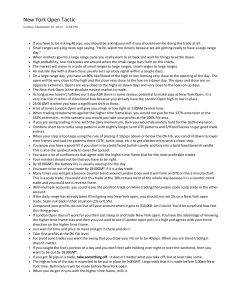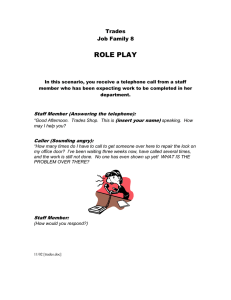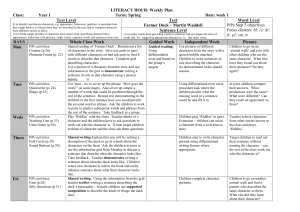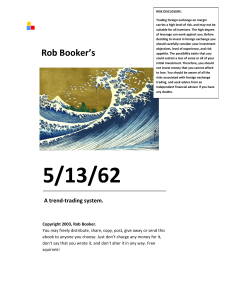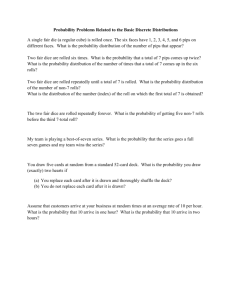Forex Trading Strategy: Order Blocks, Oscillators, Price Action
advertisement
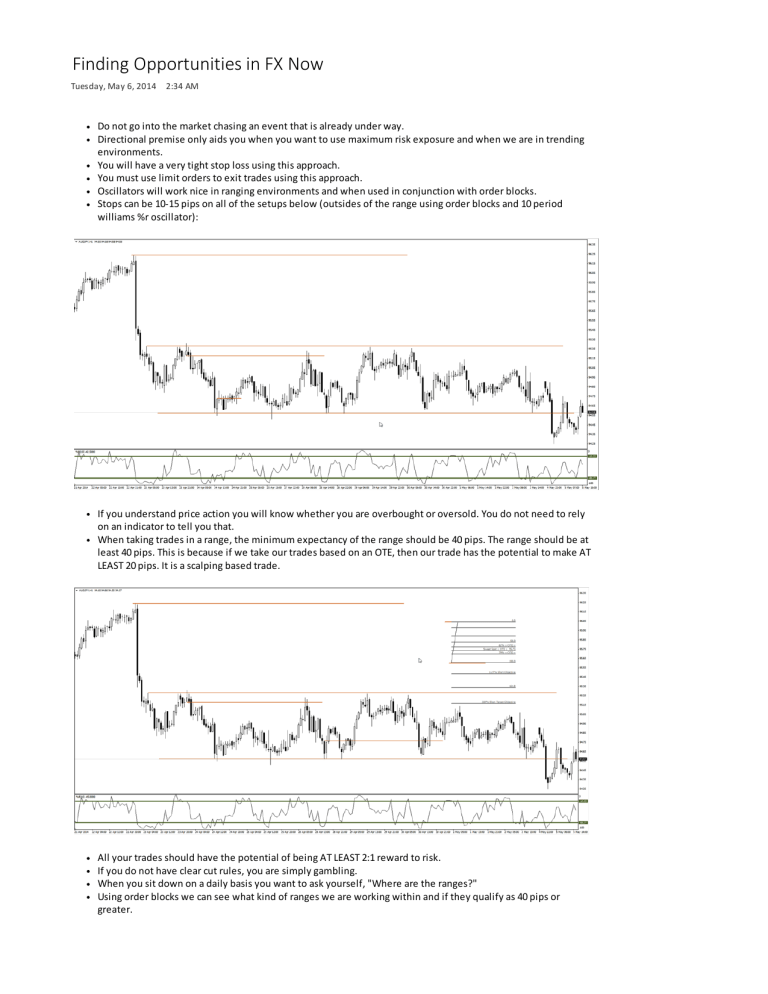
Finding Opportunities in FX Now Tuesday, May 6, 2014 2:34 AM Do not go into the market chasing an event that is already under way. Directional premise only aids you when you want to use maximum risk exposure and when we are in trending environments. You will have a very tight stop loss using this approach. You must use limit orders to exit trades using this approach. Oscillators will work nice in ranging environments and when used in conjunction with order blocks. Stops can be 10-15 pips on all of the setups below (outsides of the range using order blocks and 10 period williams %r oscillator): If you understand price action you will know whether you are overbought or oversold. You do not need to rely on an indicator to tell you that. When taking trades in a range, the minimum expectancy of the range should be 40 pips. The range should be at least 40 pips. This is because if we take our trades based on an OTE, then our trade has the potential to make AT LEAST 20 pips. It is a scalping based trade. All your trades should have the potential of being AT LEAST 2:1 reward to risk. If you do not have clear cut rules, you are simply gambling. When you sit down on a daily basis you want to ask yourself, "Where are the ranges?" Using order blocks we can see what kind of ranges we are working within and if they qualify as 40 pips or greater. You only make the trades with a pattern and the pattern will exist on a smaller time frame, but it has to trade into that level first. When you have a muddled range, just sit on your hands and wait for a true range to appear. Below is an example of measuring a range that is greater than 40 pips so it would be a valid trade if a pattern forms once it trades up into a bearish order block. Support and resistance is more important than order blocks. Support and resistance is where you expect order blocks to materialize. We have to trade AFTER smart money does the real buying or selling. We hunt reactions at key support levels. In the image below we see that price reacted at a key support level and it did not spend much time there. We wait and be patient for price to trade back into a bullish order block that formed around the support. You will get paid if you are patient enough to wait for the setup. Retail traders do not buy the market up like the bounce in the image below. Below is an example of overlaying a Fibs on top of all the concepts discussed in the image above. If we take the trade here, will it allow us to make AT LEAST 20 pips? Since the range from the high down to the low is 40 pips, it qualifies. Adding time & price theory, it happens right during the New York kill zone: The big boys cannot hide when they trade. It is really, really good when price only dips into the order block a little bit. This is what happens in the example above. You can use a combination of the top of the order block, the sweet spot, and round numbers to fine tune entries. With a firm grasp of price action concepts you can handle putting your stop loss only 5 pips under the Fib swing low instead of the usual 10 pips. This will give you a better reward:risk ratio. Below is the 15 minute chart. This is when we like candlestick patterns. You would already be in the trade, but it is still very comforting. It fits the model when you see things like that (pinbar in OTE). You can do very, very well with a small consistent amount of pips. You just need to manage the equity behind those pips. ICT's consistent return is around 20% a month comfortably. This is done with 4-6 trades per month or 1-2 trades per week while generally only focusing on 2 pairs, the Fiber and Cable. You must have fixed targets in your trading. 15 pips is a safe confluence when seeing price react at a support/resistance level. We need to allow for some slippage because trading is not black & white. The example above is not a killer trade, it is a bread and butter trade. This is something you can build a career on. ICT started out just trying to make an extra thousand dollars per month to save towards retirement so that he could retire at 40. He completely surpassed that goal just by going through the process on a consistent basis. NEVER let a winning position turn into a loss. This is just like a job. You know what you should be doing when you get there (or when price gets there). There is ZERO reason to worry about missing trades. You need to LOVE and RELISH when you make good trades like the example in this module. A profitable trade is not always a GOOD trade. Be proud of your GOOD trades and find a passion for making them. Go through every pair that you are willing to follow and see if there is an opportunity for you to find 20 pips every single day. Not that you are trading every day, but are there setups like the example in this module in at least one pair every single day? Eventually you won't even need to put a Fib up, you'll just know that price is trading into the OTE. The Fib tool gives specific finite levels to choose for entry in conjunction with order blocks. A quick way to find setups is to scroll through the 1 hour chart and look at where we are in terms of the L7 ranges and if we are trading into any order blocks. Once found, you can flip to a higher time frame to see if there is a support or resistance level to support the trade, preferably the daily chart, but you can also use the 4 hour chart. The ranges on the hourly chart are very clear. If price hits the order block before the kill zone then you just don't do anything. Time and price has to meet. When we say higher time frames we are looking at the daily, 4 hour, and 1 hour charts. Your lowest of the higher time frames is the hourly. ICT rarely gets fully stopped out. The stop loss that he places is a catastrophic stop loss that is anywhere from 2040 pips, but his mental stop loss is usually in the 10-15 pip range. He has a mental level that he is very sensitive to and will collapse the trade if it gets there. This is usually the 90% Fib level. ICT does not care about day light savings time. He uses GMT times. If you use 6:00 - 10:00 GMT to trade London, the setups will never evade you. 8:00 - 9:00 GMT is usually when the high or low is formed when price is being really precise. If you work within the weekly directional premise only, you will have absolutely stellar results.
